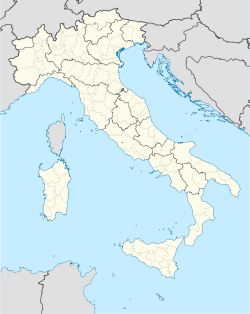- Nemi
-
- For the Norwegian comic strip, see Nemi (comic strip).
Nemi — Comune — Comune di Nemi 
Coat of armsLocation of Nemi in Italy Coordinates: 41°43′N 12°43′E / 41.717°N 12.717°ECoordinates: 41°43′N 12°43′E / 41.717°N 12.717°E Country Italy Region Lazio Province Rome Government - Mayor Alessandro Biaggi Area - Total 7 km2 (2.7 sq mi) Elevation 521 m (1,709 ft) Population (December 31, 2004) - Total 1,719 - Density 245.6/km2 (636/sq mi) Demonym Nemorensi Time zone CET (UTC+1) - Summer (DST) CEST (UTC+2) Postal code 00040 Dialing code 06 Patron saint Sts. Philip and James Saint day May 3 Website Official website Nemi is a town and comune in the province of Rome (central Italy), in the Alban Hills overlooking Lake Nemi, a volcanic crater lake. It is 6 km (4 mi) NW of Velletri and about 30 km (18 mi) southeast of Rome.
The town's name derives from the Latin nemus Aricinum, or "grove of Ariccia": the latter is a small town a quarter of the way around the lake. In antiquity the area had no town, but the grove was the site of one of the most famous of Roman cults and temples: that of Diana Nemorensis, a study of which served as the seed for Sir James Frazer's seminal work on the anthropology of religion, The Golden Bough. In 1514 Marcantonio I Colonna gave to Nemi the "Statuti e Capituli del Castello di Nemi", the first city statute with rules and regulations to observe.
Contents
Caligula's ships
Main article: Nemi shipsLater on, possibly in connection with this cult (nothing substantial is known of the matter), Caligula built several very large and costly luxury barges for use on the lake. One ship was a shrine dedicated to ceremonies for the Egyptian Isis cult or the cult of Diana Nemorensis, designed to be towed, and the other was a pleasure boat with buildings on it. After Caligula's overthrow, the boats were scuttled.
The ships were rediscovered during the Renaissance, when architect Leon Battista Alberti is reported to have attempted to raise the ships by roping them to buoyant barrels. While ingenious, this method proved unsuccessful, because of extensive rotting.
The boats were finally salvaged from 1929 to 1932 under orders of Benito Mussolini. This was just one of many attempts to relate himself to the Roman Emperors of the past. The ships were exposed by lowering the lake level using underground canals that were dug by the ancient Romans. The excavation was led by Guido Ucelli and was reported in Le Nave di Nemi by Guido Ucelli (Rome, 1950). They were destroyed by fire on 31 May 1944, it is disputed whether this was done by defeated German forces retreating from Italy at the end of World War II or accidentally by squatters taking refuge in the museum building. Surviving remnants from the excavations as well as replicas are now displayed in the Museo Nazionale Romano at the Palazzo Massimo in Rome. The ship hulls survive today at Museo delle Navi Romane, Nemi.
Other sights
Nemi itself has a few late medieval to 18th‑century churches, but its main architectural monument, dominating both town and landscape, is the Castello Ruspoli, the core of which dates to the 10th century.
Strawberries
Nemi is famous for its wild strawberries, which are smaller and sweeter than commercially grown varieties. Nemi's strawberries are grown on the sides of the volcanic crater, which creates a microclimate that retains the warmth of the sun and provides a wind shield. Nemi conducts an annual festival of strawberries.[1]
 A panoramic view of Nemi in 2006
A panoramic view of Nemi in 2006
References
External links
Categories:- Cities and towns in Lazio
- Communes of the Province of Rome
- Castelli Romani
Wikimedia Foundation. 2010.


